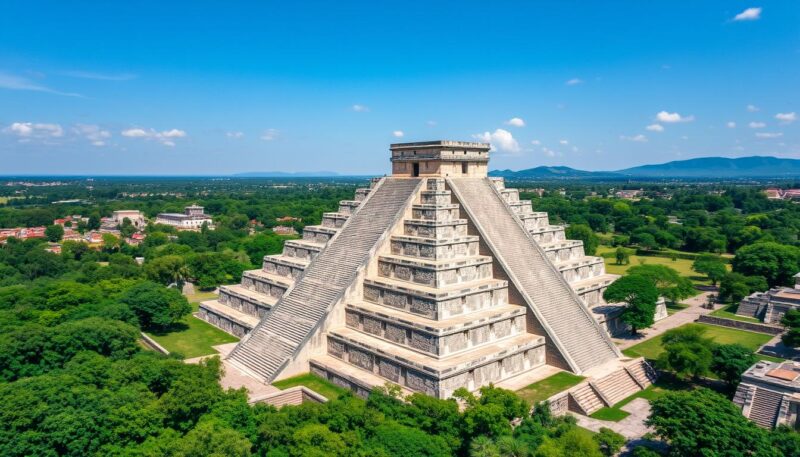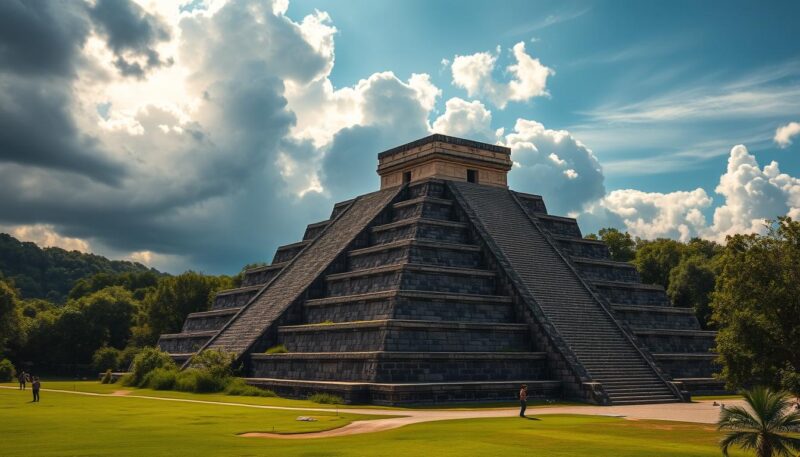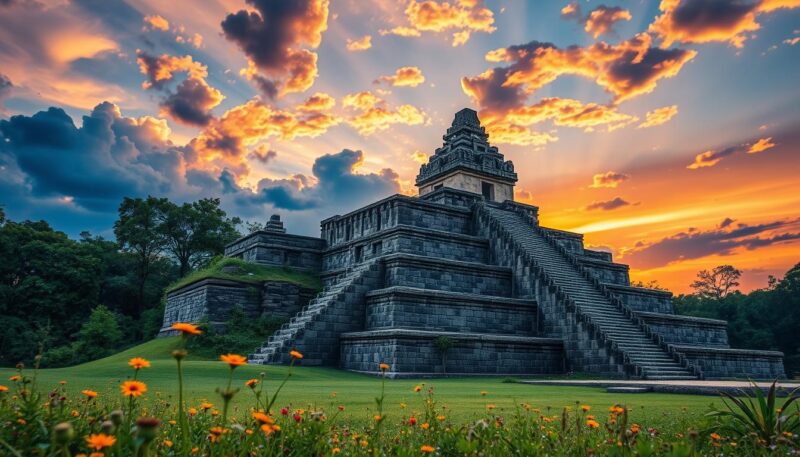Deep within the heart of Mexico lies Teotihuacán, one of the most significant archaeological sites in the world, recognized for its awe-inspiring ancient Mexican temples. Among its myriad attractions, the Temple of the Sun and Moon should be on every travel enthusiast’s list of must-visit pyramids Mexico has to offer. This monumental site thrived from the 1st to the 7th centuries A.D., once bustling with over 125,000 inhabitants. Having once been the largest city in the Western Hemisphere before the 1400s, Teotihuacán continues to captivate explorers and historians alike.
The Temple of the Sun, rising majestically, stands as the largest pyramid at Teotihuacán, while its companion, the Temple of the Moon, remains equally significant due to its central role in various ceremonial practices. With an estimated area of 83 square kilometers, the site invites visitors from all corners of the globe, offering a unique glimpse into ancient Mesoamerican civilization. Access to these wonders is surprisingly affordable, with an entrance fee of only MXN 80, or roughly $4, which includes access to both museums and the pyramids.
Whether you are a history buff or merely curious, exploring Teotihuacán provides an extraordinary opportunity to peer into the past of a civilization that left an indelible mark on the rich tapestry of human history. With ideal visiting conditions during the dry season from November to April, travelers can immerse themselves in the site’s profound legacy while avoiding the typical tourist crowds that fill the site during major holidays and weekends.
Overview of the Temple of the Sun and Moon in Mexico
The Temple of the Sun and Moon, located in Teotihuacán, represents a critical phase in the history of ancient Mesoamerican cities. The historical significance of Teotihuacán stems from its extensive influence on later civilizations, particularly the Toltecs and Aztecs, who drew inspiration from its architectural innovation and cultural practices. The city flourished between 1 AD and 500 AD, experiencing remarkable growth that has left enduring legacies in the region’s history.
Historical Significance
The historical significance of Teotihuacán is evident in how it served as a pivotal hub for trade, culture, and religious practices. Its sophisticated social structure laid the groundwork for later Mesoamerican societies. The Toltec and Aztec influence can be traced back to the city’s extensive urban planning and ceremonial importance, ideas that would manifest prominently in their architectural styles and societal norms. Findings from this area highlight numerous construction phases, suggesting a dynamic and evolving society adept at accommodating complex cultural practices.
Architectural Features
Teotihuacán is renowned for its unique architecture of ancient Mesoamerican cities, with the Temple of the Sun and Moon showcasing remarkable engineering feats. These structures include elements such as elaborate stonework and precise alignments with surrounding geological features. Notably, the Pyramid of the Sun stands tall at 65 meters, making it one of the largest pyramids, while the Pyramid of the Moon features a ritual platform known as an adosada, which likely served to restrict access to its central staircase. The architecture of these temples reflects the advanced urban planning and labor organization required for monumental construction in Teotihuacán.
| Feature | Pyramid of the Sun | Pyramid of the Moon |
|---|---|---|
| Height | 65 meters | 43 meters |
| Primary Function | Religious and ceremonial | Ritual platform |
| Construction Period | 1 AD – 500 AD | 1 AD – 500 AD |
| Significant Features | Cave beneath aligning with Quetzalcoatl narratives | Adosada structure limiting access |
Pyramid of the Sun Facts
The Pyramid of the Sun, an iconic structure in Teotihuacan, offers a wealth of fascinating history and architectural marvel. Its construction stands as a testament to the advanced engineering skills of ancient civilizations, with various components meticulously planned and executed. Insights into the construction of the Pyramid of the Sun unveil its importance in the Aztec culture and surrounding communities.
Construction and Age
The initial construction of the Pyramid of the Sun began around 100 BC, with significant phases continuing until approximately 200 AD. This timeline reflects the evolution of the pyramid, which eventually reached impressive dimensions. Constructed on top of older structures, these early foundations highlight a continuity of cultural practices present in Teotihuacan. The pyramid served vital ritualistic functions, possibly including human sacrifices, indicating its central role in ancient ceremonies.
Dimensions and Structure
The dimensions of the Pyramid of the Sun are particularly remarkable, with a height of 75 meters (246 feet) and a base measuring 225 meters (738 feet) wide. This makes it the third largest ancient pyramid in the world. The pyramid encompasses a total volume of 1,184,828.3 cubic meters (41,841,820 cubic feet). Its base perimeter stretches approximately 794.79 meters (2,607.6 feet), with a distinct angle of slope at 32.494 degrees. Such architectural feats emphasize the sophistication of the construction of the Pyramid of the Sun and its significance within the ancient city.

| Attribute | Measurement |
|---|---|
| Height | 75 meters (246 feet) |
| Base Width | 225 meters (738 feet) |
| Base Perimeter | 794.79 meters (2,607.6 feet) |
| Volume | 1,184,828.3 cubic meters (41,841,820 cu ft) |
| Construction Started | 100 BC |
| Construction Finished | 200 AD |
| Angle of Slope | 32.494 degrees |
Pyramid of the Moon History
The Pyramid of the Moon, an important ceremonial site in Teotihuacan, is believed to have been completed around 250 AD. Positioned at the northern end of the Avenue of the Dead, this significant structure provides a glimpse into the profound cultural and spiritual practices of its inhabitants. The Pyramid of the Moon has served as a focal point for ongoing archaeological investigations, shedding light on the ancient civilization’s rituals and societal organization.
Historical Context and Discovery
The history of the Pyramid of the Moon is intertwined with the development of Teotihuacan, the largest city in the Western Hemisphere before the 1400s. Initially constructed between 100 and 450 AD, the pyramid covers a structure that predates the Pyramid of the Sun, which was built prior to 200 AD. Excavations have indicated that the pyramid consists of seven layers of buildings, each larger than the last, reflecting distinct architectural advancements over time. Significant discoveries at the Pyramid of the Moon allow researchers to piece together the complex rituals surrounding burial practices and animal sacrifices.
Recent Excavations and Findings
The significance of recent excavations at the Pyramid of the Moon has yielded remarkable insights into the ceremonial use of the site. Archaeologists uncovered several sacrificial remains, including a male skeleton dated to the period of construction and a diverse array of grave goods associated with these rituals. Findings such as five canines, three felines, and numerous birds, believed to be eagles, further underscore the importance of sacrifice in Mesoamerican culture. Recent studies conducted by archaeologist Sergio Gomez and his team continue to illuminate the mysteries of the Pyramid of the Moon history, creating a deeper understanding of the ancient city’s spiritual life.

| Year | Discovery | Significance |
|---|---|---|
| 1989 | 18 sacrificial victims uncovered near the Temple of Quetzalcoatl | Insights into the sacrificial rituals of Teotihuacan |
| 2004 | 12 sacrificed individuals found at the Pyramid of the Moon | Highlights human sacrifice practices; majority were decapitated |
| 2015 | Excavation of the Temple of Quetzalcoatl revealing 75,000 artifacts | Showcases the rich material culture of Teotihuacan |
Conclusion
The Temple of the Sun and Moon in Teotihuacán stand as monumental testaments to the advanced architectural prowess of ancient Mesoamerican civilizations. This remarkable site, once the largest city in the Americas, continues to capture the imagination of visitors exploring its vast landscapes. With its extensive history dating back to around 100 AD, the cultural heritage of Teotihuacán reflects a sophisticated society characterized by impressive engineering and vibrant communal life.
Experiences at the Temple of the Sun and Moon offer a unique glimpse into the lives of Teotihuacán’s inhabitants, providing insight into their daily practices, spiritual beliefs, and artistic endeavors. From the valuable ceramics that fueled trade to the impressive pyramid complexes that defined the skyline, every aspect reinforces the significance of visiting Teotihuacán for anyone interested in history and archaeology. As you traverse the iconic Avenue of the Dead, the magnificent structures unfold their stories, ensuring that each visitor leaves with a deeper appreciation for this ancient civilization.
As the remnants of Teotihuacán continue to inspire awe, it is crucial to maintain this connection to our past. By visiting Teotihuacán, you’re not just stepping onto sacred ground but also engaging with a rich narrative that has shaped human history. Encourage fellow travelers and generations to come to embrace these wonders, celebrating the stories and cultural legacy that these great pyramids represent.

